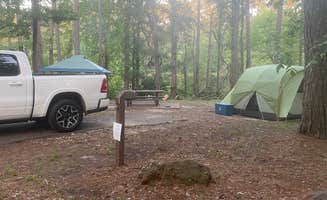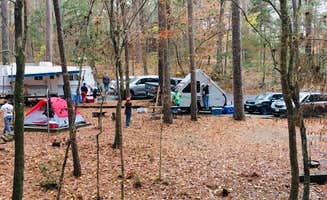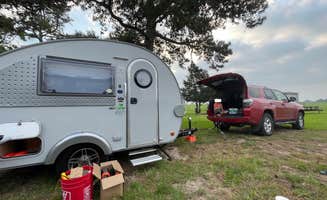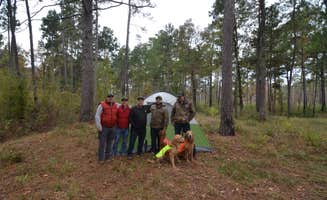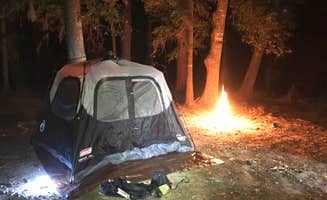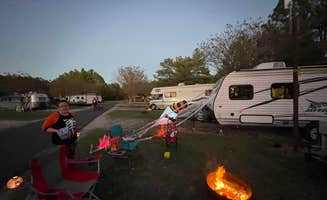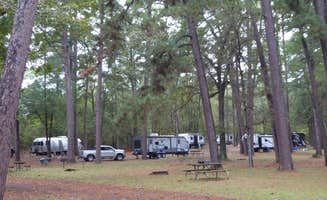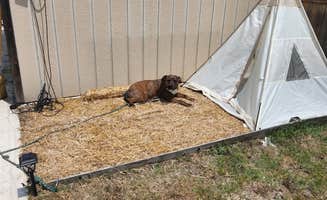Davy Crockett National Forest serves as the primary camping destination near Kennard, Texas, with over 160,000 acres of woodland habitat situated in the Piney Woods region. The area features rolling terrain with elevations ranging from 200 to 400 feet above sea level, creating natural drainage patterns that feed the Neches River watershed. Winter temperatures typically range from 35-65°F, making it popular for off-season camping when crowds thin out.
What to do
Fishing opportunities: Ratcliff Lake Recreation Area offers a small 4-acre lake where fishing from docks is productive, particularly at sunset. "We fished off of one of the docks in the evening and caught a little few perch. Enough to make me happy," notes one visitor. Bass fishing is also common.
Historical exploration: Visit the restored Rice Family Dog Run Cabin at Mission Tejas State Park Campground to learn about early settler life. A camper mentions, "Great park with a lot of history! My girls and I loved hiking on one of two parks in Texas that you can WALK on the El Camino Royal!!!"
Swimming: Most campgrounds with lakes have designated swimming areas due to safety concerns. "There is a small swim area that you should utilize because there are alligators in the lake so it's not safe to swim by the campground," advises a Ratcliff Lake camper who appreciates the safety measures.
Wildlife viewing: Early morning and dusk offer the best wildlife spotting opportunities. "Be careful during hunting season!" warns a visitor to Piney Creek Horse Camp, highlighting the need to wear bright colors during autumn hunts.
What campers like
Private bathroom facilities: The newer shower buildings at Neches Bluff Overlook Campground receive consistent praise. "Restrooms were immaculate. So peaceful and quiet at night," comments one visitor who appreciated the cleanliness.
Pine forest atmosphere: The distinctive tall loblolly pines create a unique camping environment. According to one Mission Tejas visitor, "I can't believe I'm in Texas. Beautiful tall trees. Well kept clean campsites with a fire pit. The park host brought over firewood right to our site."
Affordable camping options: Most forest service campgrounds offer budget-friendly rates compared to private alternatives. Neches Bluff campers mention the value: "Great view in mornings and nights 10/10" with no camping fees at some dispersed sites.
Fishing access: Multiple piers and shorelines provide fishing opportunities without a boat. "Good fishing, and swim area is very refreshing as well!" notes a camper at Ratcliff Lake, mentioning the dual recreational benefits.
What you should know
Water supply considerations: Several campgrounds have limited water access points. "Water is a little bit of a stretch, may need to make sure you have plenty of hose," advises a visitor to 566 Piney Creek Horse Camp, highlighting a common logistical concern.
Road conditions: Access roads to primitive sites deteriorate after rain. "The majority of roads are compacted sandy, dirt mixture making it a little dicey to travel in a heavy rig," reports a camper, suggesting visitors check conditions before arrival.
Site leveling challenges: Many campsites throughout the region require leveling equipment. One visitor notes, "If RVing, will need levelers," emphasizing the uneven terrain at many sites.
Limited connectivity: Cell service is unreliable throughout most camping areas. "Don't expect to have signal in or 20 min outside the park area so prepare for that," warns a day visitor to Mission Tejas State Park.
Tips for camping with families
Swimming safety measures: Salmon Lake Park & Resort offers family-friendly swimming features. "The lake is gorgeous and the kids like to swim in it. It has a giant slide for them and a swimming dock in the middle," describes a family that regularly visits the park.
Best family hiking trails: Several campgrounds offer shorter trails suitable for children. "Great park to shade yourself from the Texas summer sun. It was hot but 90% of the trails are covered by shade," notes a visitor to Mission Tejas, important for preventing heat exhaustion among younger hikers.
Playgrounds and recreation: Dedicated play areas exist at select campgrounds. One Salmon Lake visitor explains, "There is a playground by the lake and the lake is gorgeous and the kids like to swim in it. It is like a step back in time to the simpler days."
Wildlife education opportunities: Ranger programs occur seasonally at established campgrounds. "He said that he would meet us before we left to show us some things. So, in the morning, he showed us some skulls, animal skins, and a few dead animals," recalls a family that participated in an impromptu ranger session.
Tips from RVers
Water connections: Bring extra-long water hoses to reach distant hookups. "Nice campground area, sites are a little unlevel, but not too bad. Water is a little bit of a stretch, may need to make sure you have plenty of hose," advises an RVer at White Rock Horse Camp.
Site selection strategy: When possible, arrive mid-week for better site options. "We had RV spot #24 and you could see the lake through the trees. Our spot was nice and open and our neighbors weren't too close," shares an RVer who appreciated the spacing at Davy Crockett National Forest.
Dump station access: Not all campgrounds offer on-site dump stations. "Water and electricity at each site and a dump station at the entrance of campground," notes a Mission Tejas camper, highlighting this convenient feature not found at all nearby camping locations.
Electrical capacity: Most sites offer 30-amp service rather than 50-amp. "I spent a considerable amount of time driving around the park trying to locate a campsite that has 50-amp service," shares one RVer, suggesting those with higher power needs should plan accordingly.


